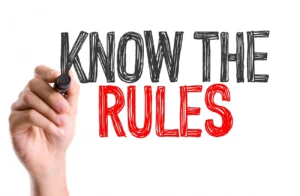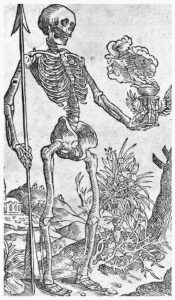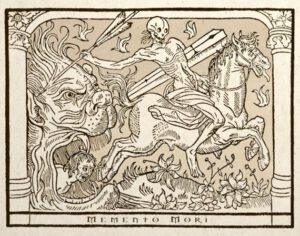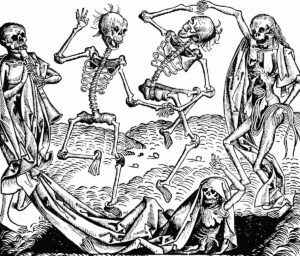 Part of an ongoing series of 5e (2014) Rules notes. See the end of the post for notes on 5.5e (2024) rules.
Part of an ongoing series of 5e (2014) Rules notes. See the end of the post for notes on 5.5e (2024) rules.
The point (very generally speaking) of D&D is to make the opponent worry about death. But it’s important for players to know about the rules, too, especially as they’ve changed since editions gone by.
Death (and Unconsciousness)
It’s important to understand a bit how down-and-out damage works in 5e. There’s no such thing as “going negative” here. When you drop to 0 HP (the bottom, you can’t go lower), you fall Unconscious (PHB 292): you’re Incapacitated, can’t move, can’t speak, are unaware, drop anything being carried, fail all Strength and Dexterity Saves … and Attacks against you have Advantage, and any hit is considered a Crit if attacked from 5 feet away.
But that’s the least worry you have. Because one of two things happen:
- If the damage was so massive that the extra damage (theoretically beyond 0) equals or exceeds your HP maximum, you are dead, dead, dead.
-

Tick-tock … If not, then you are “just” bleeding out, and need to start making Death Saves each turn (PHB 197). If you start a turn at 0 HP and are not yet stabilized, roll 1d20.
- On 10+, you succeed. Three total success, you become stable and will live.
- On 1-9, you fail (a nat 1 counts as two fails). Three total fails, you are dead, dead, dead.
- On a nat 20, you immediately gain back 1 HP and can regain consciousness.
If someone intervenes with a DC 10 Wisdom (Medicine) check, it will stabilize you, ending the Death Save checks.
Note that if someone inflicts further damage on you while unconscious, it counts as a Death Save failure; a crit (which is the auto-result of a hit from within 5′) counts as two fails. This also restarts the Death Save process. And if you take damage at 0 that is equal or greater than your normal number of HP, you die.

A stable creature stays at 0, Unconscious. It will heal 1 hp (and regain consciousness) in 1d4 hours (this does not count as a Short Rest). Healing spells are, of course, welcome to accelerate this process.
Note that this technically happens to the bad guys as well; the presumption, though, is hitting 0 kills a bad guy (they either fail their Death Saves, or you go around slitting throats after the battle). Best not to dwell on it. Powerful / significant enemies might get a Death Save process.
Taking Advantage on Death Saves

It seems clear that you can use Inspiration to gain Advantage on a Death Save (as it is, in fact, a saving throw, just not one associated with any Ability).
Indeed, as people can gift each other with their Inspiration, other folk could feed their Inspiration to a dying party member (“Don’t you die on me, man! Don’t you die on me!”)
As far as that goes, anything that helps on saving throws helps on a Death Save. So a Bless spell would work, too.
Knocking someone unconscious
Whether you want to avoid being a murder-hobo, or want to interrogate a prisoner who won’t surrender, you can intentionally knock someone out instead of death on opponents. (Vice-versa, too.)

You simply declare, on any melee (martial or spell) attack that would have killed someone, that you are instead knocking them Unconscious (PHP 292) at the moment when the DM would say they’re dead. You don’t have to proclaim “subduing” damage in advance or anything; beating someone into unconsciousness is very much the same as beating them to death: it’s all in what you do after they fall down.
A foe rendered Unconscious this way is considered stable. They will wake up (regaining 1 hp) in 1d4 hours. You can leave them behind, bind them and leave them behind, or change your mind and gack them. If you want to interrogate them, then you either need to wait, or use some healing magic on them.
Raising the Dead
There are a variety of spells that can bring back dead folk. There’s a good article here on it. In summary:
The Time Limit is how long after death the spell can be used. Note that Gentle Repose (Cleric or Paladin, 3rd lvl spell) can extend the time limit for a raise spell by 10 days if cast within the time limit for that raise spell.

As implied under Spellcasting Services (PHB 159), these revivifying spells are not the sort of thing that you find being cranked out at your local temple, and even in a Big City they’re not a commodity service. Stolen souls, headless bodies, lack of bodies, death by fire, being turned undead, can all block some of these spells. Missing body parts can be an issue. Finding a 500gp diamond might not be easy, either. And many of these spells have consequences — limits on what they can restore (see article), being Necromantic in nature (ew), or the services that will be requested in return. (And clerical spells, esp. high level ones, have to be cast to a purpose sanctioned by the deity involved.)
Which isn’t to say it can’t happen, but don’t think of all this as the wild and wooly AD&D days when raising up dead PCs garnered as little consideration as murder-hoboing a complex (if wholly illogical) underground ecosystem.
So does any of this change under 5.5e?
 The basic progression of 0 HP –> Death Saves and how all that works is mostly the same.
The basic progression of 0 HP –> Death Saves and how all that works is mostly the same.
There are minor changes in death-undoing spells. Reincarnate incorporates the updated species options in the PHB. Resurrection no longer cures non-magical diseases.



Aha! Maybe you are the source of all the errors! A nat 20 saving throw does not count as two successes. It brings you instantly back up into conciousness with 1 HP. If you are going to do blog posts on a topic, can you please look up and check rules and try to get them correct?
As in, that was the rule in 2014 rules as well. 2024, 5.5e did not change this.
Yes, you’re correct (as my players noted when the situation came up). I’m not sure where I made the initial mistake for 5e here (the 5e/2014 SRD is pretty clear). I’ll correct the text appropriate here. Apologies to anyone who was confused by my confusion.